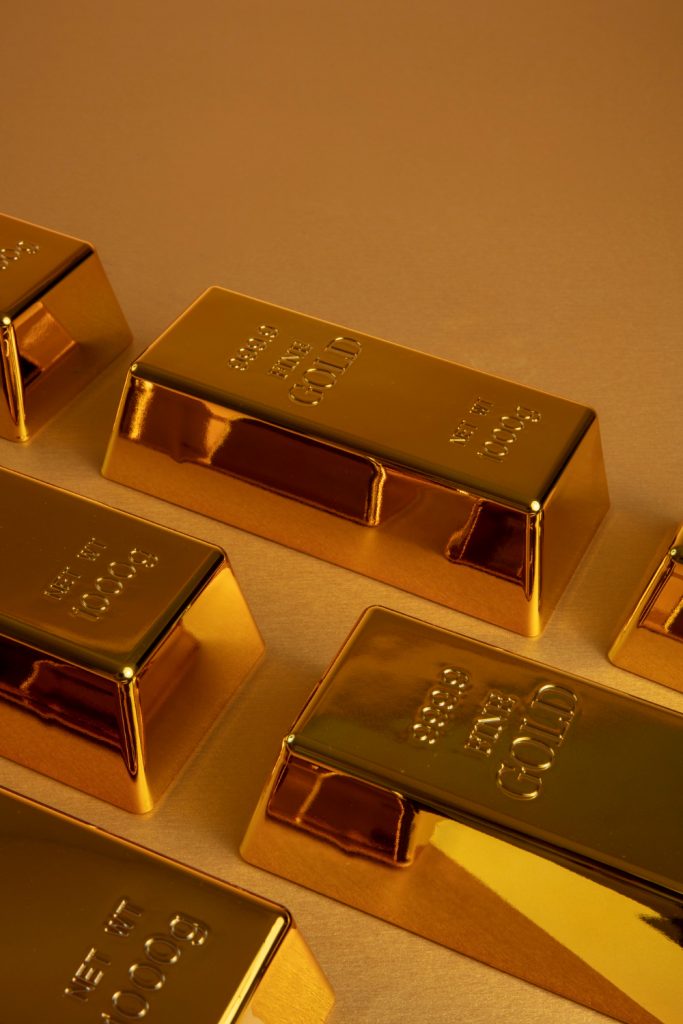Throughout history, gold investment have rivaled in popularity as a hedge against almost any trouble, from inflation to economic upheaval or currency fluctuations, to war. When you think about investing in gold, don’t restrict yourself to buying physical gold, like coins or bullion. Alternatives to invest in gold include buying shares of gold mining companies or gold (ETFs).
How to Invest in Physical Gold
Investing in physical gold can be challenging for investors more accustomed to trading stocks and bonds online. When it comes to physical gold, you’ll generally be interacting with dealers outside of traditional brokerages, and you’ll likely need to pay for storage and obtain insurance for your investment. The three main options to invest in physical gold are bullion, coins, and jewelry.
Gold Bullion
Gold bullion comes in bars ranging from a few grams to 400 ounces, but it’s most commonly available as one- and 10-ounce bars. Given that the current gold price is around $1,900 per ounce (as of September 2020), this makes investing in gold bullion an expensive proposition. And unlike stocks, there’s no way to get a fractional share of a gold bar.
If you choose to invest in gold with bullion, it’s also a good idea to stay current on the price of gold, so you can pick the right time to buy—most dealers update their prices based on current spot prices.
Gold Coins
The most common gold coins weigh one or two ounces, though half-ounce and quarter-ounce coins are also available. Collectible coins, such as South African Krugerrands, Canadian Maple Leafs and American Gold Eagles, are the most widely available type of gold coins. Some dealers even sell blanks and damaged or worn coins.
You may be able to find better deals on gold coins from local collectors or pawn shops, but it’s still typically safer to make purchases using a reputable, licensed dealer.
Gold Jewelry
You may also opt to buy gold you can wear—or that someone once wore but has been damaged—in the form of gold jewelry. Investing in gold jewelry, however, carries many risks that investing in pure gold doesn’t.
First, you have to be careful about jewelry purchases as not all secondhand jewelry is sold by reputable dealers. Not only does authenticity matter to you—but it will also matter to anyone you try to resell the piece to. This makes it crucial you buy gold investment jewelry from a reputable dealer and obtain as much documentation as possible.
Second, you’ll pay some amount of markup based on which company designed and manufactured the jewelry. This could be anywhere from 20% to more than three times the precious metal’s raw value.

Which Is A Better Investment Gold Jewelry or Gold Bullion?
When shopping for gold you can expect to pay a premium, regardless of whether you buy gold bullion or jewelry. When investing in fine jewelry you should expect premiums to be significantly higher than regular bullion. Craftsmanship and brand name contribute to the final price of jewelry, whereas the spot price primarily dictates the bullion price. You will likely get more for your money when you invest in bullion.
There is something to be said for those who simply love wearing and owning fine jewelry. Sometimes, that is a buyer’s top priority. Jewelry can also hold sentimental meaning, especially when it is an heirloom passed through generations.
If you want to invest in gold jewelry to give to your children or grandchildren, know that the melt value will likely be less than what it was valued when you purchased it. Still, you could be creating a new family tradition or heirloom—and that is valuable in a personal way.
Should You Invest in Gold?
If you’re concerned about inflation and other calamities, gold may offer you an investing haven. Though in the shorter term, it can be just as volatile as stocks, over the very long term, gold has held its value remarkably well.
Depending on your preference and aptitude for risk, you may choose to invest in physical gold, gold stocks, gold ETFs, mutual funds, or speculative futures and options contracts. Regardless of the form of gold you choose, most advisors recommend you allocate no more than 10% of your portfolio to it.
Any form of investing carries risks. Gold is no different. But the idiosyncratic gold market isn’t forgiving and takes a long time to learn. This makes gold ETFs and mutual funds the safest choice for most investors looking to add some of gold’s stability and sparkle to their portfolios.
People who choose to invest in gold via options or futures contracts need to actively monitor their holdings so they can sell, rollover, or exercise their options before they expire worthless. In addition, each of these options includes a certain degree of leverage, or debt, by default, so investors who overuse them and experience market losses can see their losses mount quickly.
Source: www.forbes.com | www.apmex.com

0 Comments